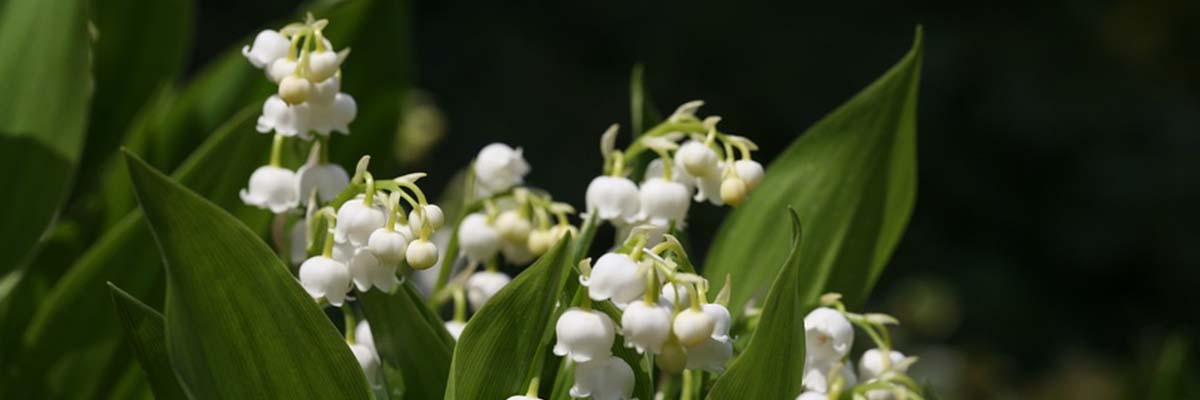
Lily of the valley: planting and care
Contents
Lily of the valley in a nutshell
- Understorey plant that prefers cool conditions and partial shade
- Symbol of May Day, sprig of lily of the valley charms with delicate scented white or pink bell-shaped flowers, set in a “coronet” of fresh green leaves
- Lily of the valley flowers perfume garden in mid-spring
- Low-maintenance and very hardy, lily of the valley is easy to grow in almost all regions and spreads abundantly
- Ideal for creating tapeta of flowers in all cool, shaded areas of garden
A word from our expert
According to tradition, a sprig of lily of the valley is the must-have flower to give on 1 May as a good-luck charm.
Although it also refers to the disease that develops on a baby’s tongue and in the mouth, lily of the valley (convallaria majalis), “May lily” or “Florists’ lily”, is above all a lovely little docile perennial very easy to grow in our wild, wooded gardens.
Its pure white or pink bells perfume the garden in spring with their sweet, slightly musky scent and are well suited to being planted in pots on a terrace or near a pathway.
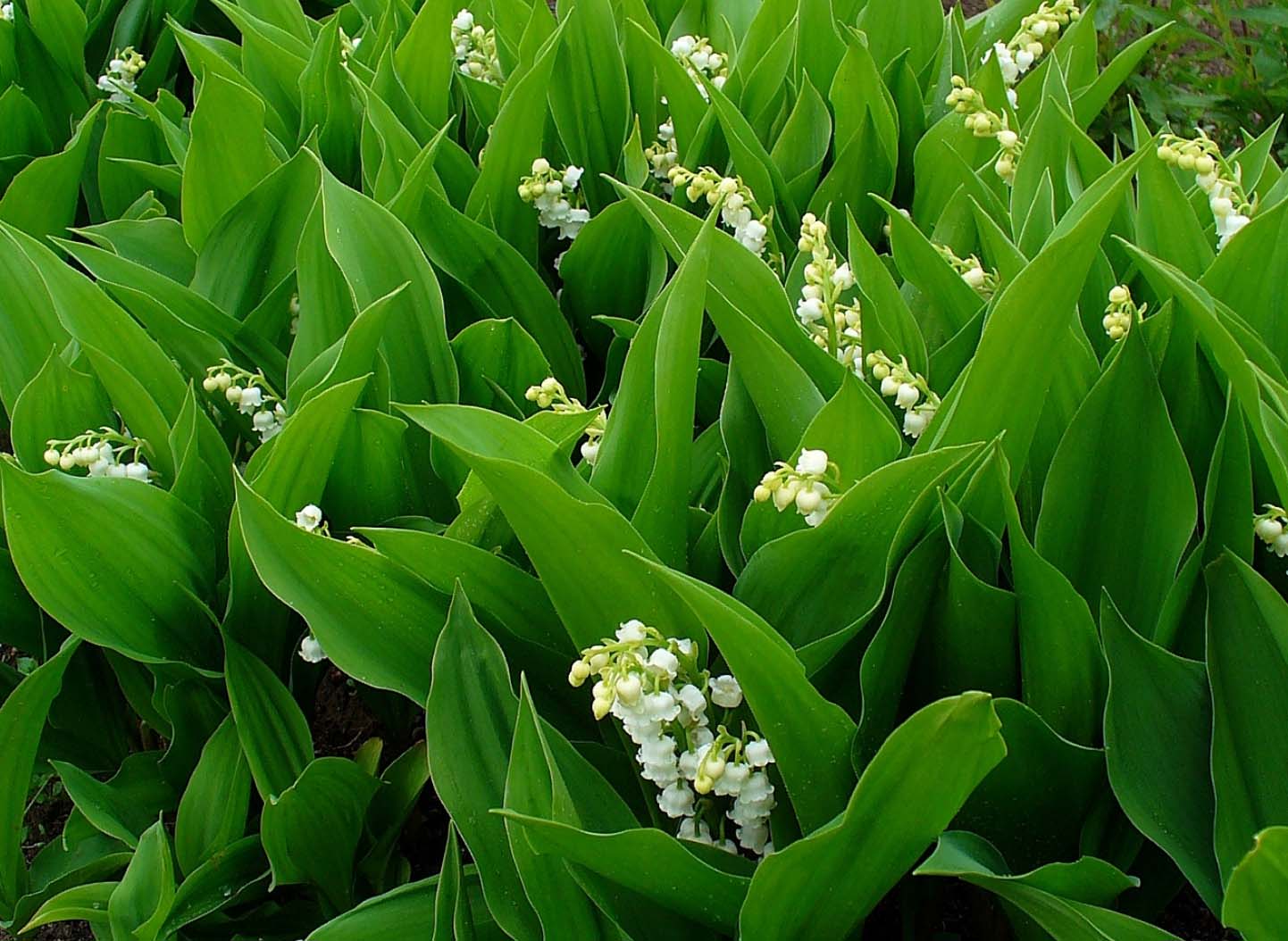
Behind its appearance as a delicate, discreet flower, lily of the valley reveals an appreciable robustness as groundcover beneath trees, at the edge of borders or along paths.
If lily of the valley grows wild in our undergrowth, it will thrive in any shady, cool corner of your garden, colonising large areas if conditions suit it: take care, however, as the seeds of lily of the valley are highly toxic.
Rediscover this pretty little emblematic flower of May, easy to live with, perfectly hardy, which grows everywhere, requiring no maintenance.
Description and botany
Botanical data
- Latin name Convallaria majalis
- Family Liliaceae
- Common name Lily of the valley, May bells, Mary's tears
- Flowering April-May
- Height 0.15-0.30 m
- Sun exposure Sun, partial shade
- Soil type Moist, well-drained
- Hardiness -15°C to -20°C
Convallaria majalis, commonly called Lily of the valley, “Florist’s lily of the valley”, “May lily” or “Valley lily”, belongs to family Liliaceae. This perennial rootstock plant grows in open woodlands, groves and alpine meadows up to 2000 m altitude in temperate regions of Northern Hemisphere. In France, it occurs wild in most regions, except around Mediterranean coast.
Genus Convallaria includes only one species, which is represented by a few interesting cultivars such as Convallaria majalis ‘Rosea’ with pink bells, or the Nantes-grown cultivars ‘Fortin’ or ‘Géant Français’ produced intensively in Nantes region.
Lily of the valley spreads slowly in clumps about 25 cm high (30 cm maximum), with a maximum spread of around 50 cm, thanks to its robust, creeping and ramified rootstocks (crowns). Very prolific, even invasive once established, it will flower for years, naturalising easily, forming in a few years scented flowering carpets.
From this rootstock deeply anchored in soil emerge early in spring the green leaves, recognisable by their basal, horn-shaped form. Deciduous foliage appears before flowering.
Leaves, ovate to lanceolate and elliptical, are inserted in pairs at base of a slender, unbranched peduncle. Measuring 4 to 20 cm long and 3 to 6 cm wide, thick and veined, they are medium to fresh green, sometimes streaked with narrow off-white or yellow lines, as in cultivar ‘Albostriata’.

Convallaria majalis – botanical illustration
From early spring, Lily of the valley displays its luminous flowering, forming waves of pure white or pink-tinged blooms.
Around May, sometimes as early as April depending on region, a naked, upright and graceful flowering stem, wrapped only at base by two large leaves, appears. Small flowers 0.5 to 1.5 cm diameter, in the form of pendulous little bells with six recurved teeth, are grouped in an arched lateral cluster on the stem.
Each bell is borne on a pedicel. Each stem bears about 20 bells, nearly ten of which remain closed. Of waxy texture, they are white, sometimes pinkish. Some cultivars such as Convallaria majalis ‘Flore pleno’ bear double flowers.
These lily-of-the-valley bells exude a characteristic, floral, fresh and penetrating scent, much sought after in perfumery as a heart note.
This remarkable flowering for its scent and freshness is unfortunately fairly brief and lasts only three to four weeks, ending in June.
Stems make of course very pretty cut flowers and feature in small, fresh and fragrant bouquets.
From July, these highly fragrant bells turn into small, round, smooth, bright red berries that are extremely toxic if ingested in large quantities.
Very hardy and easy to grow, Lily of the valley thrives everywhere and spreads rapidly in partial shade in all soils that are fairly fertile, moist, light and well-drained.
In garden, Lily of the valley composes very delicate scenes and flourishes as flowering carpet, in understorey at tree bases, as edging, in rockeries, scattered in a short grass meadow or even in containers in spring.
By tradition, sprig of Lily of the valley is offered on 1 May as a good-luck charm; it is now associated with Labour Day.
Lily of the valley is classed among “plants of high toxicity” because of its bells and red fruits, which contain a compound similar to digitalin used in treatment of cardiac conditions.
Its fresh, intoxicating scent inspired many perfumers, including famous fragrance “Diorissimo”.
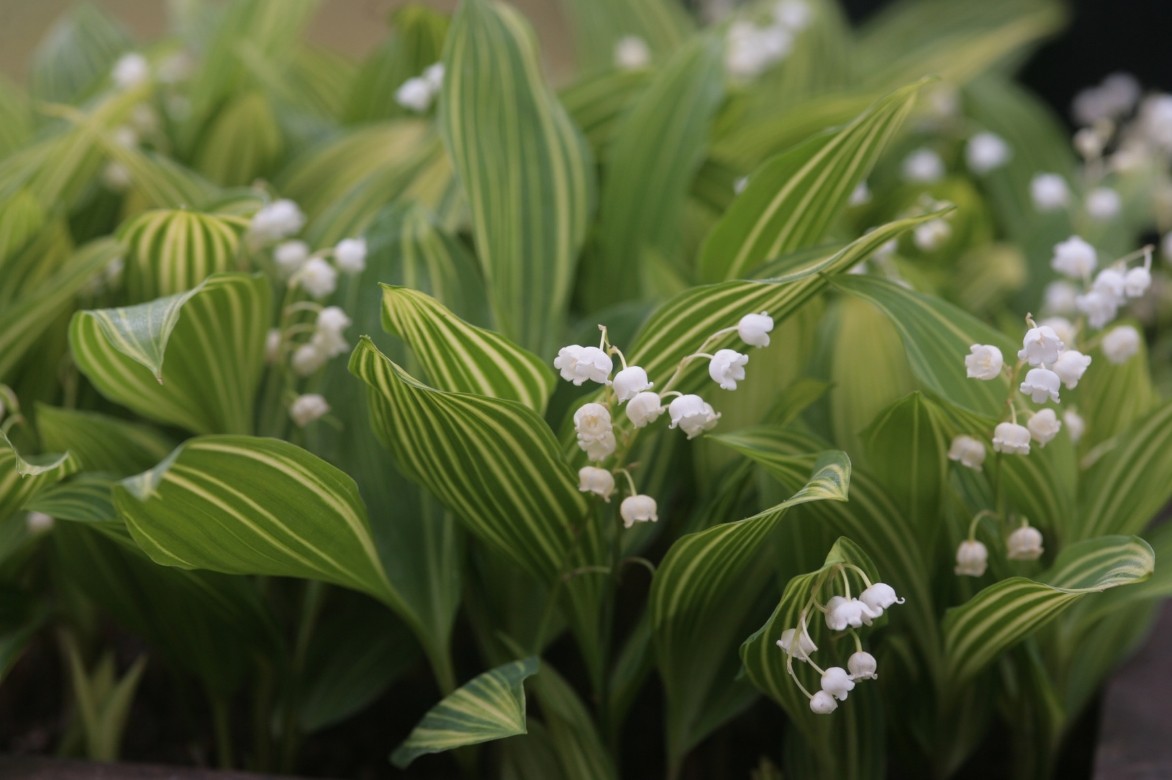
Attractive variegated foliage of Convallaria majalis ‘Albostriata’
Main species and varieties
Only one species of lily of the valley, Convallaria majalis, exists and is available in a few rather limited but interesting cultivars with pink, double or giant flowers.
Our favourites
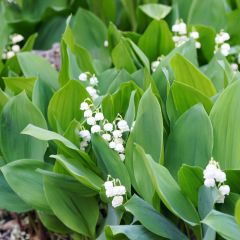
Convallaria majalis - Lily of the Valley
- Période de floraison May, June
- Hauteur à maturité 20 cm

Convallaria majalis var. rosea - Lily of the Valley
- Période de floraison May, June
- Hauteur à maturité 20 cm
Planting lily of the valley
Where to plant lily-of-the-valley?
Perfectly hardy at least down to -15°C in all regions, perhaps avoiding overly dry Mediterranean climate, lily-of-the-valley forms flowering carpets and can be readily invasive.
It is an indestructible plant once well established.
Although accommodating regarding climate, soil and exposure, lily-of-the-valley prefers partial shade and cool conditions, although it will grow without problem in dry shade.
It dislikes strong sun, which it will only tolerate where summers are cool. It roots itself in any ordinary, fairly fertile, cool but above all well-drained soil: it needs a light soil as it fears excess water.
Allow space for this prolific perennial likely to spread indefinitely and colonise large areas: it makes an excellent groundcover in shaded, cool and neglected parts of the garden, places where nothing else grows, in the shade of trees in particular, whose roots it does not fear.
It establishes itself in all natural, wild and wooded gardens.
Plant beneath deciduous trees, on woodland edge, at edge of a bed or an avenue, in small delicate touches in a rockery, near a path to enjoy its unique scent, along an east-facing wall or in a bucket or planter.
When to plant lily-of-the-valley?
In bucket, lily-of-the-valley is planted in spring, from February to April; bare roots (bare roots/crowns) are best planted at start of autumn, from September to November, avoiding freezing periods.

How to plant lily-of-the-valley?
For a good groundcover effect, plant generously in a lightened garden soil, at a rate of 5 plants per m² spaced 10 to 30 cm apart. Improve drainage if necessary with addition of compost and sand.
In open ground
How to plant lily-of-the-valley crowns?
- Work soil well by digging to spade depth
- Remove roots and stones from soil
- Dig a hole 2 to 3 times the size of the rootstock
- Spread a good layer of drainage material at bottom of hole
- Add compost
- Bury crowns shallowly at 2 to 3 cm depth, shoot facing upwards
- Backfill leaving this pointed end slightly protruding
- Maintain spacing of 10 to 30 cm between each crown
- Water thoroughly
Plant lily-of-the-valley in bucket
- Work soil well
- Dig a hole 2 to 3 times the volume of the bucket
- Place rootball in centre of hole
- Spread a drainage layer (gravel, stones) at bottom of hole to improve drainage
- Add compost to garden soil
- Water
Plant lily of the valley in pot
- Spread a layer of clay pebbles or gravel at bottom of pot or planter
- Plant in a mix of compost or leaf mould
- Cover plants
- Firm soil and water without excess
Pruning and care of lily of the valley
Lily of the valley is a perennial plant that requires very little maintenance.
It simply needs regular watering during the first months after planting to allow the root system to develop deeply.
It prefers soil that remains cool to flower well and spread generously: carry out regular watering throughout summer, especially in Mediterranean regions.
Lily of the valley likes soils rich in humus: in autumn, add compost at base of young plants; they will flower well the following spring.
After flowering, you can cut off spent stems to prevent toxic fruiting that can attract children and pets.
Thin out if plant becomes too invasive: pull up or move rootstocks to limit colonisation.
It is not necessary to cut foliage until it has died back: leaves will fall naturally.
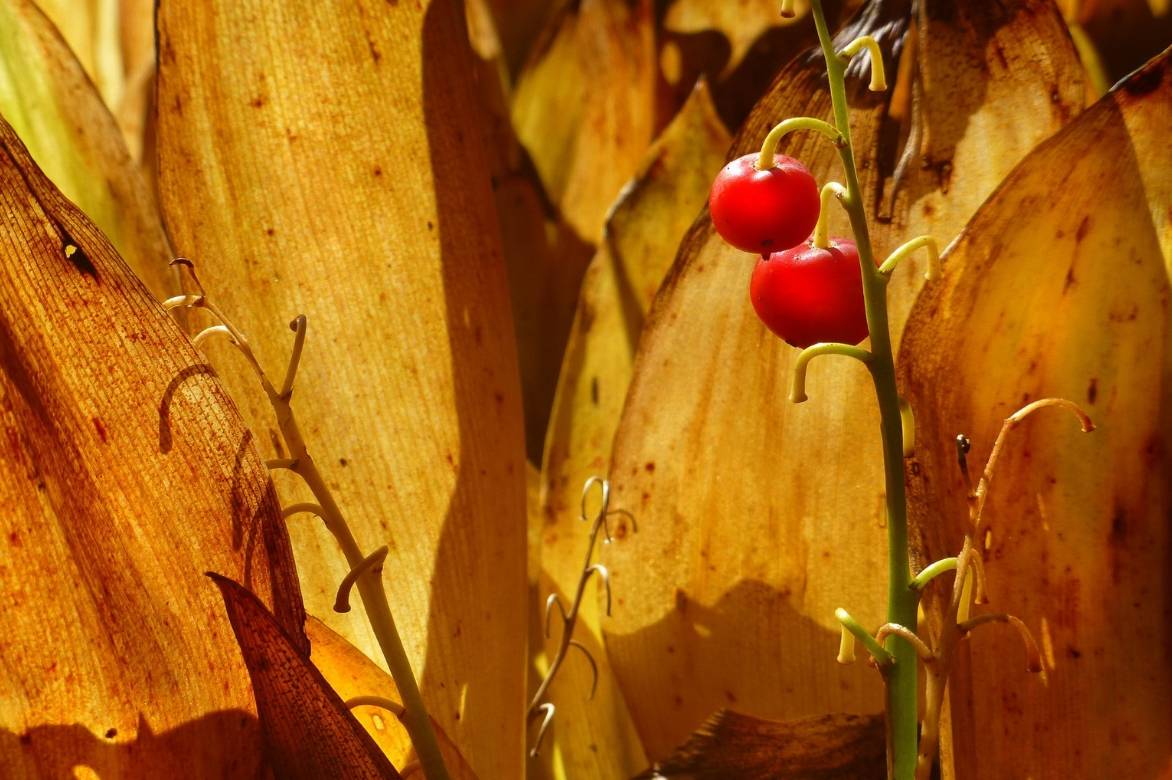
Red berries of lily of the valley
Potential diseases and pests
Le Lily of the valley has few enemies. Not very susceptible to disease, it only suffers from heavy, compact and overly wet soils responsible for grey root rot, botrytis, a fungus that causes grey mould on the stems, leading to death of young plants. That is why it is imperative to plant it in very well-drained soil and to avoid waterlogging the soil.
Propagation
How to propagate Lily of the valley to enjoy it from May? Sowing Lily of the valley seeds is slow and unpredictable, especially as the plant spreads readily on its own. We recommend division of rootstocks, very simple to do in autumn.
Divide Lily of the valley clumps
Only divide the oldest clumps to thin an area or to create a new planting in the garden.
- In October, when leaves begin to yellow, use a hand fork to gently lift the clumps from the soil
- Remove dry or damaged leaves
- Using a sharp knife, divide each clump, keeping a leaf shoot on each piece
- Replant with leaf shoot facing upwards, directly into light, well-drained soil enriched with compost, in holes about 5 cm deep
- Firm the soil and water
- Cover with a mulch of dead leaves, compost or potting compost
→ Find out more about the dividing Lily of the valley in our tutorial!
Companion planting: lily of the valley
Fresh and discreet, Lily of the Valley thrives in low-maintenance, wooded and naturalistic gardens, where it forms tapeta of white or even pink flowers in spring. It is a staple of white gardens.
It is essential in fresh settings imbued with delicacy, inspired by white/blue, white/yellow or white/green palettes.
With its fragrant, luminous flowering, it thrives alongside other shade-loving perennials and dry-shade perennials such as Omphalodes, hardy geraniums cantabrigiense, Epimediums or fairy wings.

An idea for a woodland combination: Convallaria majalis, Geranium cantabrigiense ‘Biokovo’, Epimedium pubigerum ‘Orangekönigin’, Brunnera macrophylla ‘Jack Frost’, Dryopteris erythrosora
It forms fragrant, flowering groundcovers and accompanies flowering of other scented perennials or small spring bulbs to naturalise such as Muscaris, anemones, hyacinths, scillas, ipheions, narcissi.
In a slightly wild understorey, it naturalises easily, in company with primroses, white dead-nettles, violets, Vinca Minor or Dichondra repens or creeping bugle.
It finds its place perfectly beneath cover of deciduous bushes such as azaleas or roses.
Leaves of Lily of the Valley, in a lively green, harmonise well with fronds of the hart’s-tongue or with contrasting foliage of early or evergreen ferns or finely dentate Corydalis.

Another example of a combination: Convallaria majalis ‘Rosea’, Corydalis flexuosa ‘Purple Leaf’, Vinca minor ‘Gertrude Jekyll’, Adiantum aleuticum ‘Imbricatum’ (photo InAweofGod’sCreation)
In a shaded border, it pairs with bleeding hearts, Arums, Ophiopogons.
In a pot, it mixes with Muscaris, pansies, narcissi, hyacinths or primroses.
Useful resources
- Discover all our scented perennials
- What to plant under trees?
- Find out more about toxic berry plants
Frequently asked questions
-
What exposure for lily of the valley?
Lily of the valley is an understorey plant. It prefers light shade and cool conditions. It will thrive at the foot of deciduous trees in loose, well-drained soil. However, it can tolerate exposure to sun in regions with a cool summer climate.
- Subscribe!
- Contents
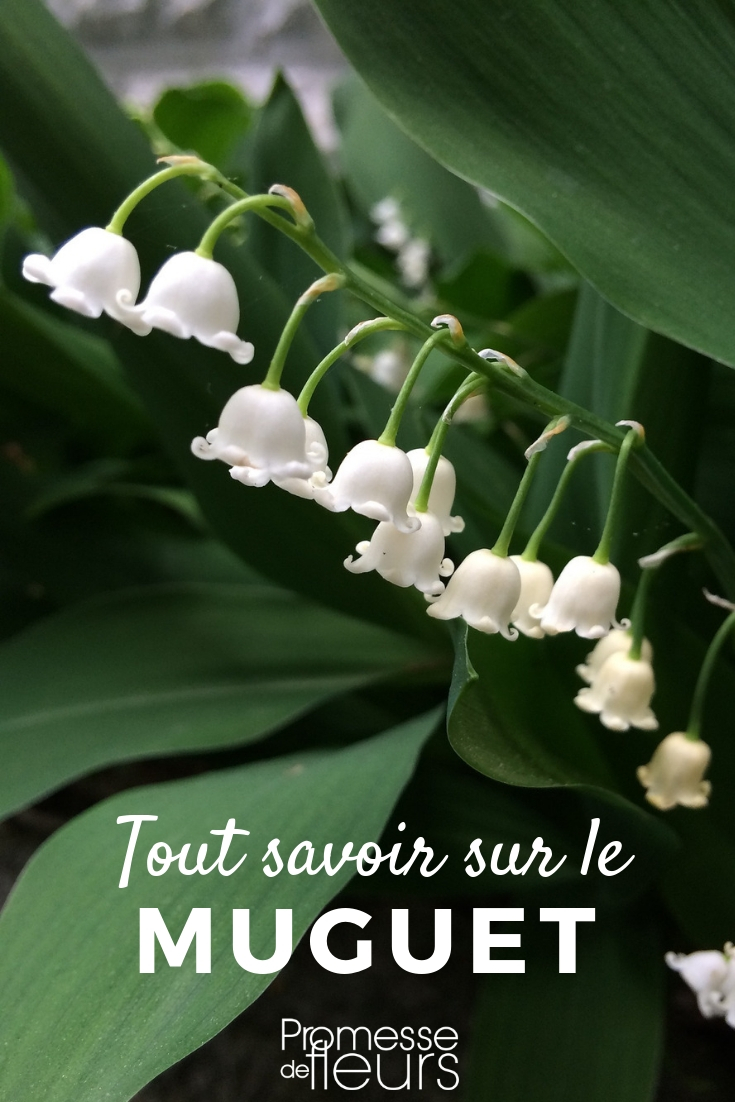































Comments